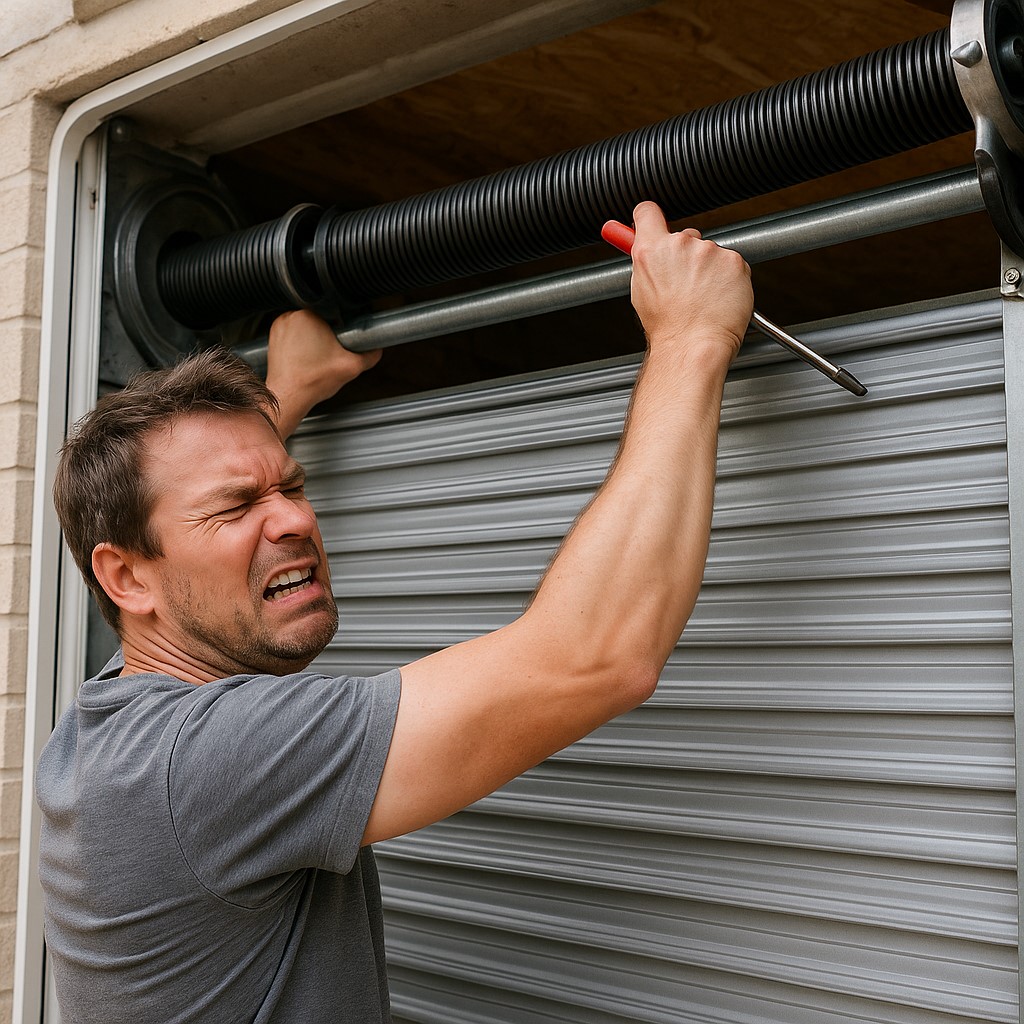Earlier this year in Bellaire, TX, a homeowner attempted a DIY new garage door installation after purchasing a discounted door and opener online. Unfortunately, improper track alignment and miscalculated spring tension caused the door to crash during its first use, destroying the opener and damaging the garage floor. This is a clear example of how a seemingly cost-saving choice can turn into an expensive mistake.
Statistics from the National Electronic Injury Surveillance System (NEISS) reveal that garage doors cause more than 20,000 injuries every year in the U.S., many due to improper installation. These incidents include pinched fingers, collapsed panels, and injuries from high-tension springs, all of which are preventable with professional installation.
Your garage door is not just a functional component, it’s a moving wall that can weigh over 300 pounds, especially with insulated steel doors. From maintaining curb appeal to ensuring energy efficiency and home security, making the right decision on how to install your new garage door sets the foundation for long-term safety, savings, and satisfaction. That’s why Champion Garage Doors is committed to helping homeowners across Bellaire and the Houston area with expert guidance, quality products, and top-tier service for every new garage door installation project.
Understanding the Garage Door Installation Process
A quality garage door installation is a structured, multi-step procedure that requires precision, the right tools, and professional knowledge. Each phase plays a critical role in ensuring the door operates smoothly, safely, and efficiently. Below is a comprehensive breakdown of what goes into a successful installation:
1. Pre-Installation Planning and Site Assessment
The first step begins with a detailed inspection of the garage structure. Installers measure the width, height, headroom, and side room to determine the right door size and track type. They assess the condition of the existing door frame and garage ceiling to confirm they can support the new system. Any signs of rot, warping, or misalignment are addressed before the installation begins. This step ensures that the new garage door will be compatible with your garage’s layout and meet local building codes.
2. Choosing the Right Door and Components
Next, homeowners choose a door that fits their preferences and functional needs. This includes selecting materials (steel, wood, aluminum, fiberglass), insulation levels (R-value), panel style (flush, raised, carriage), color, and decorative hardware. Professionals help match the door to the home’s architecture and climate, offering guidance on wind-load ratings, energy efficiency, and smart technology compatibility.
3. Removing the Old Door System

Carefully dismantling the existing door involves detaching the opener, releasing spring tension, and removing panels, tracks, and brackets. Safety is critical here, as improperly released springs can snap back with enough force to cause serious injury. Professional installers use specialized tools to safely disassemble and dispose of the old system.
4. Assembling and Installing the New Tracks and Hardware
Once the garage is prepared, the installation team installs vertical and horizontal tracks, mounting brackets, and other essential hardware. Tracks must be perfectly aligned and level, as even small misalignments can affect door performance. Reinforcement struts may be added to support heavier doors or improve wind resistance.
5. Setting the Door Panels in Place
Door panels are stacked and secured one at a time, beginning with the bottom panel. Each panel is attached to rollers and hinges, which connect to the tracks and allow the door to glide smoothly. The bottom panel must seal firmly with the floor to keep out weather, debris, and pests.
6. Installing the Spring System
Torsion or extension springs are mounted based on the door design. Springs are critical for counterbalancing the door’s weight, making it easier to lift manually or with an opener. Installers wind torsion springs to precise tension levels to ensure balanced lifting and safe operation. Mistakes here are among the most dangerous DIY errors.
7. Mounting and Configuring the Garage Door Opener
The opener system is mounted to the ceiling or wall and connected to the door via a drive carriage and rail system. Whether using a chain, belt, or screw drive (such as a Stanley garage door opener), installers ensure proper alignment and setup. Smart openers are configured with Wi-Fi, mobile apps, and security features like auto-lock and motion detection.
8. Calibrating, Testing, and Final Adjustments
With the system fully installed, the door undergoes testing. Installers check:
- Door balance and alignment
- Opener response and force sensitivity
- Safety sensors and auto-reverse function
- Noise levels and smooth movement
If needed, they fine-tune spring tension, track position, and opener settings to guarantee optimal performance.
9. Post-Installation Walkthrough and Maintenance Education
Finally, installers provide homeowners with a walkthrough of the system’s features and offer maintenance tips. They explain how to operate the opener, use emergency release systems, maintain lubrication, and inspect critical components. This final step ensures the homeowner knows how to care for their new garage door properly and when to schedule service calls.
Understanding each part of the installation process helps homeowners see the value of hiring experienced professionals. From start to finish, professional installers follow a systematic approach that prioritizes safety, durability, energy savings, and homeowner satisfaction.
DIY Garage Door Installation: Pros and Cons
Advantages
- Lower Initial Cost:
DIYers avoid labor costs, thinking they can save money. - Flexible Scheduling:
Work can be done at your own pace and during your free time. - Personal Satisfaction:
Completing a project yourself can offer a sense of accomplishment.
Risks and Disadvantages
- Safety Concerns:
Incorrect handling of high-tension springs can result in serious injury. The average garage door weighs over 150 lbs. DIY mistakes can lead to falls, crush injuries, or worse. - Improper Alignment and Operation:
A poorly aligned track or door panel can cause the opener to malfunction, leading to jerky motion or complete failure. - Warranty Issues:
Many garage door and opener manufacturers void warranties if the installation wasn’t done by a certified installer. - Higher Long-Term Costs:
Fixing a bad installation often costs more than hiring a professional from the start. - Lack of Tools and Materials:
Essential tools like torsion spring winders, alignment gauges, and hardware kits may not be available to the average homeowner.

Professional Garage Door Installation: Why It’s Worth It
1. Safety Comes First
Professionals understand the dangers associated with spring tension, panel weight, and opener configurations. They use specialized tools and follow safety procedures, reducing the risk of injuries.
2. Efficient Installation Process
What might take a DIYer two full days can be completed by a professional installation team in just 4 to 6 hours. Their experience streamlines every step of the process.
3. Proper Calibration
Professionals ensure that:
- The torsion spring is perfectly tensioned.
- Safety sensors are aligned and tested.
- The garage door opener is set with correct force and travel limits.
- All panels align for smooth operation.
4. Warranties and Guarantees
A reliable company provides warranties for both materials and labor. This means you’re covered in case of any malfunction.
5. Energy Efficiency and Insulation
Professionally installed garage doors often include high R-value insulation, weatherstripping, and airtight sealing that help conserve energy and improve your home’s energy efficiency.
6. Security and Smart Features
Experts ensure the proper setup of:
- Smart garage door openers
- Remote access controls
- Security locks and alarm features
These additions increase your home’s security and convenience.
7. Custom Design and Enhanced Curb Appeal
A garage door makes up a large portion of your home’s facade. A professional can help choose the right style, material, and decorative hardware to enhance curb appeal.
Local Benefits for Bellaire, TX Homeowners
Dealing with Houston Weather
Professional installers account for Bellaire’s heat, humidity, and occasional tropical storms. They install weatherproofed, insulated garage doors that withstand local climate challenges.
Building Code Compliance
Your installer ensures that your new garage door meets all relevant codes, including wind resistance requirements in hurricane-prone regions.
HOA and Neighborhood Aesthetics
In upscale areas like Bellaire, West University Place, and Meyerland, the right garage door adds value and maintains neighborhood consistency. Professionals help you match your home’s exterior and satisfy HOA guidelines.
Cost Comparison: DIY vs. Professional
| Feature | DIY (Estimated) | Professional Installation |
| Materials Cost | $600–$1,200 | $1,200–$2,000+ |
| Tools Needed | $150–$300 (purchase/rent) | Included in service |
| Time Required | 2–3 days | 4–6 hours |
| Risk of Injury | High | Minimal |
| Quality of Installation | Varies | Guaranteed |
| Warranty Coverage | Often voided | Included for both labor/material |
| Long-Term Performance | Uncertain | High |
| Maintenance Requirement | Higher | Minimal with proper installation |
Over time, the professional route proves more cost-effective, more reliable, and far less stressful.
Factors to Consider When Choosing a Garage Door
Selecting the right garage door for your home is a critical decision that affects not only curb appeal but also functionality, energy efficiency, and security. With so many options available in materials, styles, and features, understanding what factors to consider will help you make an informed choice that fits your lifestyle and budget.
1. Material and Durability
Garage doors come in various materials, each with its own benefits and maintenance requirements:
- Steel: Durable, low-maintenance, and cost-effective; available in insulated or non-insulated models.
- Wood: Offers a traditional look but requires regular upkeep and may not perform as well in humid climates.
- Aluminum: Lightweight and rust-resistant, ideal for coastal areas, but can dent more easily.
- Fiberglass or Vinyl: Resistant to moisture and cracking; good for high-humidity environments and requires little maintenance. Choose a material that suits your local climate, aesthetic preferences, and daily use.
2. Insulation and Energy Efficiency
Insulated garage doors help regulate indoor temperatures and reduce energy costs. Look for the door’s R-value, which indicates insulation effectiveness:
- Higher R-value = better insulation and energy savings.
- Important for attached garages or those used as workspaces. Double or triple-layer doors with polyurethane or polystyrene insulation help conserve energy and minimize noise.
3. Style and Curb Appeal
Garage doors are a large visual element of your home. Consider:
- Panel Design: Traditional raised, flush panels, carriage-house style, or modern full-view options.
- Color Options: Match or complement your home’s exterior.
- Windows and Decorative Hardware: Add personality and natural light while enhancing the facade. Customizable doors can significantly increase curb appeal and property value.
4. Security and Smart Features
Security is essential for any entry point to your home. Consider doors that offer:
- Reinforced construction and tamper-resistant locks
- Rolling-code technology for openers to prevent code-grabbing
- Smart home compatibility enables remote access, alerts, and monitoring via smartphone apps. These features help protect your belongings and increase convenience.
5. Maintenance Requirements
Different materials and designs have varying maintenance needs:
- Steel and vinyl: Require occasional cleaning and minor touch-ups.
- Wood: Needs staining, painting, and inspections for rot.
- Glass and aluminum: Require cleaning but are relatively low-maintenance. Choose a door that aligns with how much upkeep you’re willing to perform regularly.
6. Cost, Warranty, and Value
Balance initial costs with long-term benefits:
- Initial Cost: Depends on material, insulation, size, and customization.
- Warranty: Look for strong manufacturer and installation warranties for peace of mind.
- Value: A quality garage door can recoup up to 94% of its cost in home value during resale, according to industry reports.
7. Installation and Support Services
Ensure you choose a door that is backed by professional installation and local service support. Having access to expert installers and maintenance teams ensures long-term performance and reliability. Ask about service plans, availability of replacement parts, and emergency repair options.
Taking all these factors into account ensures that your garage door not only meets your current needs but also serves as a durable, efficient, and attractive addition to your home for years to come.
Maintenance Tips After Installation
Even a professionally installed garage door needs regular maintenance:
- Lubricate tracks, rollers, and springs every 6 months.
- Clean and inspect door panels for dents or weather damage.
- Check the balance of the door.
- Test the safety sensors monthly.
- Schedule a professional tune-up annually.
Consistent upkeep prevents costly repairs, extends the door’s life, and maintains safe operation.
Warning Signs of Poor Installation or Wear
- Jerky or noisy operation
- Gaps under the bottom panel
- Uneven tracks or misalignment
- Garage door opener straining or failing
- Door is not sealing properly
Address these issues promptly to avoid accidents and prolong system life.
How Can Champion Garage Doors Help You?
At Champion Garage Doors, we specialize in both residential and commercial garage door installations across Bellaire, TX, and surrounding Houston communities. Whether you’re upgrading an old door, remodeling your house, or completing a new build, our certified team ensures your garage door project is handled with precision and care.
Here’s what we offer:
- Fast, professional installation process
- High-quality garage doors and openers
- Expertly calibrated springs, tracks, and hardware
- Energy-efficient models with premium insulation and weatherproofing
- Smart home-compatible openers for remote access
- Stylish design options to boost curb appeal
- Maintenance and repair services for long-term reliability
We’re your trusted partner for every step of your garage door installation journey.
Visit Us At:
Vintage Park Blvd Ste A, Houston, TX 77070, United States
Call Now: (281) 609-9466
Let our installation team handle the heavy lifting. Skip the DIY risks and enjoy a safe, smooth, and stylish garage door experience with Champion Garage Doors.
Frequently Asked Questions (FAQs)
1. How long does a professional garage door installation typically take?
Most standard installations are completed within 4 to 6 hours, depending on door size, materials, and opener configuration.
2. Can I reuse my existing garage door opener with a new door?
In many cases, yes—if the opener is compatible and in good working condition, but professionals will assess its performance and compatibility first.
3. What type of garage door is best for hurricane-prone areas?
Wind-rated steel doors with reinforced panels and secure tracks are recommended for homes in hurricane zones like parts of Texas.
4. How often should I replace garage door springs?
Torsion springs generally last about 10,000 cycles, or 7 to 10 years with average use, and should be inspected annually by a professional.

